
Park offers peek at breathtaking coral reef
HOMESTEAD, Fla.— The waves roll gently and corals sway with the current. Fish dart here and there. This scene is one of the most breathtaking in the world and it can be found right here at Biscayne National Park.
Biscayne National Park is 95 percent under water and contains four different ecosystems, one of which is the coral reef. This reef is the start of the third longest reef in the world and North America’s only barrier reef.
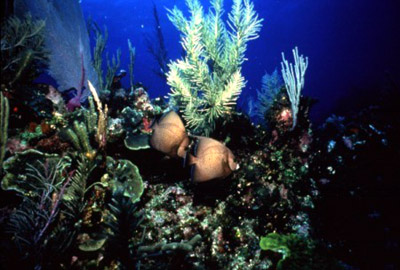 |
Fish swim along the coral reef in Biscayne National Park (Photo courtesy of the National Park Service). |
“The park is home to 512 species of fish,” Ranger Bob Showler said. “There are fewer vertebrate species in Yellowstone National Park, the nation’s premier park, than species of fish that live in Biscayne Bay.”
Showler has been a ranger at Key Biscayne for two and a half years. Prior to that, he worked at national across the country, most recently the Everglades National Park.
“My favorite aspect of the reef is the great feeling of a bustling city,” Showler said. “It grabs your attention with its color, life, and diversity. You feel like you are in a different world.”
The coral reef is the second-most diverse ecosystem in the world, second only to the tropical rainforest. Almost 80 percent of Western Atlantic coral species exist in the Biscayne reef, along with one third of Florida’s endangered species. Endangered species of turtle swim around the reef, as well as crabs, sponges, algae, fish, and mollusks.
Hard corals are the most dominant type of coral on the reef. They are called hard coral because the polyps deposit limestone around themselves for protection. The bleached limestone is sometimes sold in gift shops.
The polyps themselves are soft tubes that inhabit the wholes in the limestone. The shapes of the holes vary by which species lived in it. At night, the coral open their tentacles to snatch passing food. These tentacles are not visible during the day.
However, plankton, the coral’s food source, does not provide all the nutrients that the coral needs . Algae provide additional nutrients. The algae live in the coral, giving coral its color and performing photosynthesis. The algae also use the coral’s waste to survive. The water provides little nutrients, which is why it is so clear.
The algae must be kept in check so that it does not overrun the reef. Other animals living on the reef eat algae, such as the parrot fish. The parrot fish grinds up the coral to extract the algae. Its defecation is sand. Think about that the next time you lie on the beach.
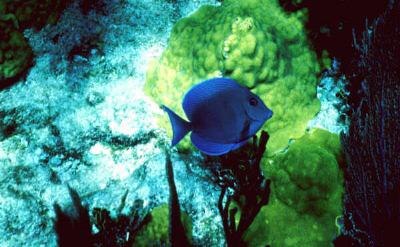 |
A bluetang fish swims past colorful coral in Biscayne National Park (Photo courtesy of the National Park Service). |
Other animals such as the sea cucumber and various worms also consume the coral’s waste and produce raw materials. This cycle is just part of the complex symbiotic relationships that exist on the reef.
The reef is home to many different types of coral. Pillar coral earns its name because it grows in the shape of a pillar. Brain coral looks like a giant brain and usually grows in calmer waters. The more colorful coral are the soft species, which include the sea whips, sea fans, and sea plumes. These coral move with the current.
Elkhorn and staghorn coral are species of hard coral. They grow branches and tend to look like forests. However, snorkelers would be hard pressed to find many of them on the reef. Both species have recently been put on the endangered list.
| A marine researcher collects data from a coral reef site in Biscayne National Park (Photo courtesy of the National Park Service). |
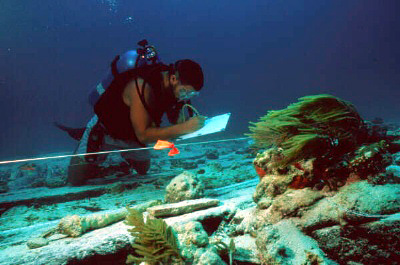 |
Many colorful fish can be seen swimming through the reef. Triggerfish, parrot fish, angel fish, and damselfish are the most colorful. Groupers, barracudas, southern sharks, and moray eels may be less vibrant, but they are still fascinating fish. If the diver looks closely at the bottom, he can see crabs, lobsters, and clams. Sponges also lie scattered throughout the reef.
“I was surprised by the number of different animals on the reef,” said first time diver Nate Burton. “You felt like you were a fish swimming through it.”
Showler gives a 10-minute briefing before snorkelers leave for the reef. In addition to showing coral skeletons, he teases them with his natural history facts.
“The parrot fish can change sex,” Showler said. “A young female can become a male if the conditions warrant.” He has many more fascinating facts about the underwater world.
| A solitary queenfish swims along the coral reef in Biscayne National Park (Photo courtesy of the National Park Service). |
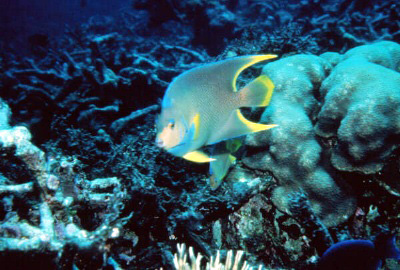 |
The reef is ever changing.
According to Diego Lirman, a researcher at the Rosenstiel School of Marine and Atmospheric Science at the University of Miami, the reef has been deteriorating for the past 20 to 30 years.
“A variety of factors have combined to cause the damage, such as pollution, humans, and warmer water,” Lirman said.
As for the increased hurricane activity, Lirman said the damage done by these storms is minimal compared to other elements.
Lirman has been working on the Biscayne reef for 15 years, both as a graduate student and a professor. He does research on the reef as well as the seagrass beds that are in the bay.
“The seagrass beds have suffered less damage than the coral reefs,” Lirman said. There is a definite distinction between the seagrass beds and the coral reef. If the conditions are rough, instead of snorkeling on the reef, the rangers take the divers to the bay.
“Touching coral kills it,” Showler cautioned divers before they set off on their adventure. “So don’t touch it!
As coral reefs across the world slowly deteriorate, the time to snorkel is now. There is no better place to go than the beautiful waters of Biscayne National Park.
Friendly rangers take boaters and divers out to the reefs daily. Whether viewing the reef through the glass bottom of a boat or through a mask, the beauty and diversity will overwhelm you.
| A school of porkfish swims in Biscayne National Park (Photo courtesy of the National Park Service). |
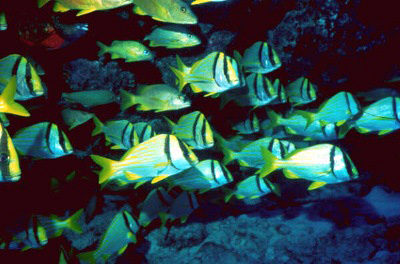 |
If You Go
Biscayne National Park
Follow signs off the Florida Turnpike Extension to SW 328th Street and the bay, about nine miles west of Homestead.
Contact:
Phones: 305-230-7525 for the Visitor’s Center, 305-230-1100 for tour reservations.
E-mail: divebiscayne@bellsouth.net.
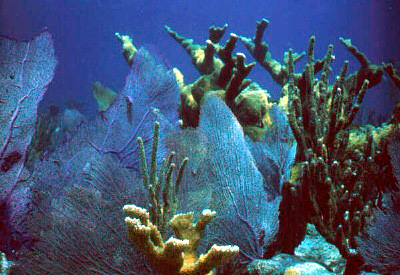 What to do:
What to do:
Glass bottom boat tours
10 a.m. – 1 p.m. daily
$24.50 for adults.
Snorkel trips
1:30 – 4:30 p.m. daily
$35 for adults.
Scuba trips
8:30 a.m. – 1 p.m. Saturday and Sunday
$54 for adults.
If you bring your own boat, the water is open 24 hours a day.

Comments are Closed